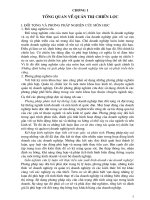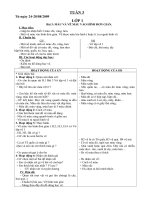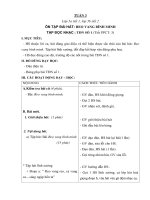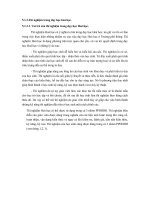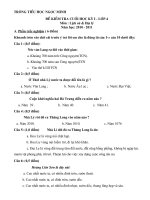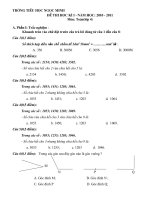5 1 3 stuks village TG
Bạn đang xem bản rút gọn của tài liệu. Xem và tải ngay bản đầy đủ của tài liệu tại đây (114.31 KB, 4 trang )
5.1.3
Stuk’s Village
SUMMARY
This is a fictional story about a
Native American boy named Stuk who lives
in the village of Shisholop, on the California
coast. Stuk describes how his people live,
eat, and trade. He also talks about the
stories the elders tell to explain the stars
and the weather.
LESSON VOCABULARY
gnawed
kelp
ravine
sinew
headland
lair
shellfish
INTRODUCE THE BOOK
INTRODUCE THE TITLE AND AUTHOR Discuss
with students the title and the author of
Stuk’s Village. Based on the illustrations, ask
students what kind of information they think
this book will provide. Ask them what they
think the author’s purpose is for writing this
book.
BUILD BACKGROUND
Discuss what students
know about Native Americans. Ask them to
think about stories they have read that taught
them about Native Americans. Prompt them
to discuss what kind of houses the Native
Americans lived in, what they ate, and what
they traded.
SETTING AND THEME
VISUALIZE
READ THE BOOK
SET PURPOSE
Have students set a purpose for
reading Stuk’s Village. Suggest that students
think about how Native Americans lived and
worked.
STRATEGY SUPPORT: VISUALIZE
As students
read about Stuk’s life, visualizing gives them a
chance to imagine how Native Americans lived
many years ago. Ask students to imagine what
it would be like to be a Native American child
in early history.
COMPREHENSION QUESTIONS
PAGE 3
What is the setting? (Shisholop village,
many years before European settlers arrived)
PAGE 3
What words or phrases on this page
help you visualize the setting? (round house of
willow and grasses; beds of rushes and mats;
pillows and blankets of fur)
PAGE 8
What is the theme here? (Trading is
important to the people in the village.)
PAGE 13 What is the author’s purpose here?
(to inform the reader about the things that
Native Americans traded)
PAGE 19 How does the story say the stars
were made? (The sun breaks a torch in two,
and the stars are the flying sparks.)
PREVIEW/USE TEXT FEATURES
As students
preview the book, ask them what the
illustrations tell them about the book. Draw
their attention to the illustration on page 6
and ask them how this is a clue to the story’s
content. Have them tell you if they think this
book is fiction or nonfiction.
20
Stuk’s Village
16911_LRD_TG_020-021 20
6/16/06 12:10:24 PM
REVISIT THE BOOK
READER RESPONSE
Skill Work
1. Possible response: beach, ocean,
mountains, huts, canoes, people of the
village at work.
2. Responses will vary, but may include feast,
roasted fish, dance, sing, make music.
3. homograph—bail: security given
for temporary release of prisoner;
homophone—bale: large bundle of goods;
sentences will vary.
4. Responses will vary.
TEACH/REVIEW VOCABULARY
EXTEND UNDERSTANDING
Have students look up each
vocabulary word in a dictionary and write
the definitions. Then have them write the
definitions in their own words.
As students review
the book, ask them to name some of Stuk’s
character traits. Prompt them to think about
his interaction with other characters in the
book.
RESPONSE OPTIONS
WRITING
Suggest students imagine what it
would be like to live as a Native American
child 400 years ago. Prompt them to think
about where they would live, what they would
eat and do for fun, and what they would learn.
Ask them to write a journal entry about a day
in the life of a Native American child.
SOCIAL STUDIES
CONNECTION
Students can learn more
about Native American
tribes, like the Chumash, by
researching them on the Internet or in the
library. Encourage them to find out about a
child their age in a Native American tribe.
Have students look up each vocabulary word
in a dictionary and write the definitions.
Then ask them to write a sentence using
each vocabulary word. Encourage them to
use as many vocabulary words in a sentence
as they can, making sure the sentences are
logical. Then have volunteers share their
sentences with the class or write them on
the board.
TARGET SKILL AND STRATEGY
SETTING AND THEME
Remind students
that setting is the time and place in which
a story occurs. As students read, ask them
to write down the setting of the story and
to ask themselves: How does the setting go
along with the theme? Remind students that
theme is the underlying meaning of a story,
a “big idea” that stands on its own outside
a story. As students read, have them answer
the following question: What does the writer
want me to learn or know from reading this
story?
VISUALIZE
Remind students that to
visualize is to create a picture in the mind.
As students read, prompt them to pay close
attention to the descriptions and sensory
details. Ask students if the mental pictures
that they form as they read are similar to
the illustrations in the book.
ADDITIONAL SKILL INSTRUCTION
AUTHOR’S PURPOSE Remind students that
an author’s purpose is his or her reason for
writing. Remind them that the four main
reasons for writing are to persuade, inform,
entertain, and express. Ask students to
name two reasons the author may have had
for writing this book.
Stuk’s Village
16911_LRD_TG_020-021 21
21
12/28/05 12:49:39 PM
Name
Stuk’s Village
Setting and Theme
• Setting is the time and place in which a story occurs.
• Theme is the subject or idea that a story is about.
Directions Based on your understanding of Stuk’s Village, answer the questions below.
1. What is the setting of the story?
2. How would the story be different if it were set in a different time?
3. What is the story’s theme?
© Pearson Education 5
4. Does the theme depend on the setting of the story? Why or why not?
22
16911_LRD_TG_022-023 1
12/28/05 12:50:07 PM
Stuk’s Village
Name
Vocabulary
Directions Complete each sentence with a word from the word box.
Check the Words You Know
gnawed
kelp
ravine
sinew
1. The fish hide in the
2. The dog
3. My family eats
4. The
headland
lair
shellfish
.
on the bone.
on Fridays.
flooded when it rained a lot.
5. We made rope from the animal’s
6. She stood on the
7. The fox sleeps in the
.
to see the boats coming.
by the tree.
Directions Write the vocabulary word that belongs with each group of words below.
8. gully, valley,
9. tendon, vein,
10. chewed, nibbled,
© Pearson Education 5
Directions Write a summary of Stuk’s Village using as many vocabulary words as you can.
23
16911_LRD_TG_022-023 2
12/28/05 12:50:08 PM
